South Africa, a nuclear power until 1989
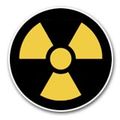
The South African nuclear program began in 1944. In the 1950s, South Africa sent its scientists to study nuclear physics
in the United States under the aegis of the "Atoms for Peace" program. The Atoms for Peace program distributed nuclear
technology, materials, and know-how to many countries with less advanced research. Two years earlier, in 1948, the Atomic
Energy Board was established. Research started at the university of the Witwatersrand, which set up a nuclear physics research unit in 1957.
In the same year South Africa and the United States signed a bilateral agreement for nuclear collaboration. Pelindaba,
the South African Atomic Research centre, west of Pretoria, was established in 1960. And 5 years later (1965) the first
research reactor (Safari-1 nuclear reactor) was opened at Pelindaba. It became operational in 1967.
SAFARI-1 is a 20 MW research reactor. The reactor is a tank in pool type reactor and is designed to run on Highly enriched Uranium.
Pool-type reactors, also called swimming pool reactors, are a type of nuclear reactor that has a core immersed in an open pool of water.
The reactor was built in cooperation with the Atoms for Peace program run by the US DOE in the 1950s and 60s.
The United States supplied its highly-enriched fuel and trained South African technicians to operate it. In 1970 the South
African government established the first uranium-enrichment plant, known as the Y - Plant. The Valindaba site, also
known as Pelindaba East or Y-plant was an experimental uranium enrichment plant.
South Africa.Mr B.J. Vorster, the prime minister of South Africa, announced in July 1970 that South African researchers
at Pelindaba had developed a new process of producing enriched uranium. In 1971 South African Minister of Mines Carl
de Wet approves research on PNE's (Plowshares Peaceful Nuclear Explosion). The Atomic Energy Commission (AEC)
was in charge of the research. The PNE program marks the beginning of the South African nuclear weapons program.
When exactly it became a nuclear weapons program is still under debate. On 1 April 1971 the Uranium Enrichment Corporation (UCOR) was set up.
It later (1980's) merged into South Africa’s Atomic Energy Corporation. The Nuclear Fuel Corporation (NUFCOR) has also been established.
The South African government, concerned about the Soviet expansionist threat, decides in 1974 to build nuclear weapons
(gun-type fission weapons). A nuclear weapon is an explosive device that derives its destructive force from nuclear reactions,
either fission or a combination of fission and fusion. There are two basic types of nuclear weapon.
The first type produces its explosive energy through nuclear fission reactions alone. Such fission weapons also commonly referred to
as atomic bombs or atom bombs (abbreviated as A-bombs).
The second basic type of nuclear weapon produces a large amount of its energy through nuclear fusion reactions. Such
fusion weapons are generally referred to as thermonuclear weapons or more colloquially as hydrogen bombs (abbreviated as H-bombs).
Fission refers to the splitting (fissioning) of a large nucleus into two smaller ones.
Fusion refers to the building up of a small nucleus from two smaller ones.
Gun-type fission weapons are fission-based nuclear weapons whose design assembles their fissile material into a
supercritical mass by the use of the "gun" method: shooting one piece of sub-critical material into another.
The construction of a bore hole at a test site in the Kalahari Desert at the Vastrap weapons range north of Upington begins
in 1975. Two test shafts were completed. One shaft was 385 meters deep, the other, 216 meters. In 1977, South Africa
completed its first full-scale nuclear device. However, the device did not have enough highly enriched uranium (HEU) to be
fully operational (Y-Plant had not yet produced enough weapon-grade uranium for such a device).
Now remember that in 1977, according to foreign press reports, it was suspected that South Africa signed a pact with Israel that included the
transfer of military technology and the manufacture of at least six nuclear bombs. According to the Nuclear Threat Initiative,
in 1977 Israel traded 30 grams of tritium in exchange for 50 tons of South African uranium and in the mid-80s assisted with
the development of the RSA-3 ballistic missile. (A ballistic missile follows a sub-orbital ballistic flightpath with the objective
of delivering a warhead (often nuclear) to a predetermined target.)
A test ("..a cold test without fitting the device with U-235") at Vastrap was planned by the AEC for August 1977. But Soviet
intelligence detected the preparations for an underground nuclear test and alerted the United States. The USSR and Western
governments were convinced that South Africa was preparing for a full-scale nuclear test. Pressure from outside
forced South Africa not to go ahead with the test.
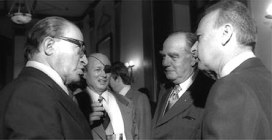
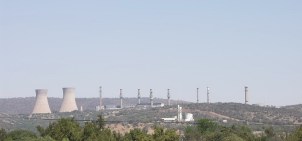
Image Left. South Africa's prime minister John Vorster (second from right), Israel's prime minister Yitzhak Rabin (right)
and Menachem Begin (left) and Moshe Dayan during his 1976 visit to Jerusalem. Photo.Sa'ar Ya'acov.
Vorster's visit laid the ground for a collaboration that transformed the Israel-South Africa axis into a leading weapons
developer and a force in the international arms trade.The biggest secret of all was the nuclear one. Israel provided expertise
and technology that was central to South Africa's development of its nuclear bombs. Ref. Brothers in arms - Israel's secret pact with Pretoria.
Image right. Pelindaba.
In 1978 the Y-Plant produced its first load of HEU. In the same year a second device was built. And by late 1979 the
Y-plant had made enough enriched uranium for a single bomb core. The second and smaller nuclear device was provided
with HEU. Thereafter the Armaments Corporation of South Africa (Armscor) took over the manufacture and assembly of
the devices. The AEC was expected to provide the weapons-grade uranium and to conduct research on development of
more advanced weapons (Albright, 1994a: 6-9). The Kentron Circle (Advena), an Armscor facility, built its first nuclear
device (the third nuclear weapon) in 1982.
A further three followed. By 1989 South Africa had built six gun-type devices.
Advena Central Laboratories were constructed in the mid-1980s to extend South Africa's nuclear capabilities from
gun-type weapons to inter-continental ballistic missile (ICBM) delivery platforms. Work to produce advanced warhead
designs was also developed. Working with Israel at Advena, a 2000 km-range missile – based on the Jericho II ICBM –
was designed and tested
The election of President F.W. de Klerk in 1989 brought an end to the nuclear weaponry program. All the bombs, 6 guntype
nuclear weapons and one under construction, were destroyed and South Africa acceded to the Nuclear Non-Proliferation Treaty in 1991.
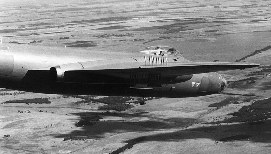
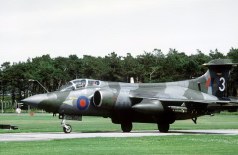
Images. The Canberra B12 (left) in service with 12 Squadron SAAF was chosen as the primary air drop vehicle as it
was highly reliable, spares were readily available from several countries (unlike the Buccaneer (right)and the maritime
reconnaissance Shackleton, grounded due to UK refusal to supply spare parts), and it had both a significantly greater
radius of action and a much higher operating altitude than the Buccaneer and Cheetah.
Ballistic missile programme
South Africa also had a relatively sophisticated intercontinental ballistic missile programme running concurrently with
the nuclear programme, and was known to be working on more sophisticated nuclear weapons capable of delivery from
such a platform. (An intercontinental ballistic missile, or ICBM, is a long-range (greater than 5,500 km or 3,500 miles)
ballistic missile typically designed for nuclear weapons delivery, that is, delivering one or more nuclear warheads ).
According to published data one of the missiles, the RSA-4, may have been capable of delivering a 700 kg nuclear warhead
from its South African launch site to any point on earth. The RSA-4, was built around the same engines that power
Israel's Jericho-II missile and its "Shavit" space launcher.
South Africa ended its missile collaboration with Israel in 1992 and then halted all ballistic missile development in
mid-1993.
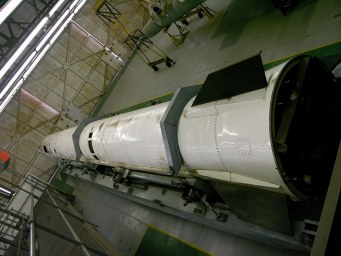
Image. RSA-3 (Shavit) LEO rocket South African Air Force Museum, Swartkop. Photo. NJR ZA
Project Coast
And then there was Project Coast, a top-secret chemical and biological weapons (CBW) program instituted by the
South African government. Project Coast was the successor to a limited post-war CBW program which mainly produced
the lethal agents CX powder and mustard gas; as well as non-lethal tear gas for riot control purposes. Project Coast was
headed by Wouter Basson, a cardiologist who was the personal physician of the then South African Prime Minister
PW Botha.
Progressively, Project Coast created a large variety of lethal offensive CBW toxins and biotoxins, in addition to the
defensive measures. Initially, these were intended for use by the military in combat.
References
http://en.wikipedia.org/wiki/Atoms_for_Peace
http://en.wikipedia.org/wiki/SAFARI-1
http://en.wikipedia.org/wiki/Gun-type_fission_weapon
http://en.wikipedia.org/wiki/South_Africa_and_weapons_of_mass_destruction
http://en.wikipedia.org/wiki/Atomic_bomb
http://en.wikipedia.org/wiki/Intercontinental_ballistic_missile
http://en.wikipedia.org/wiki/Project_Coast
http://en.wikipedia.org/wiki/Advena
South Africa's Nuclear Autopsy
South Africa's Military and Nuclear Build-Up
A Chronology of South Africa's Nuclear Program